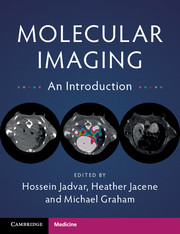Book contents
- Frontmatter
- Contents
- List of Contributors
- Preface
- 1 Instrumentation – CT
- 2 MRI/ MRS Instrumentation and Physics
- 3 Optical and Ultrasound Imaging
- 4 Instrumentation-Nuclear Medicine and PET
- 5 Quantitation-Nuclear Medicine
- 6 Perfusion
- 7 Metabolism
- 8 Cellular Proliferation
- 9 Hypoxia
- 10 Receptor Imaging
- 11 Apoptosis
- 12 Angiogenesis
- 13 Reporter Genes
- 14 Stem Cell Tracking
- 15 Amyloid Imaging
- Index
- References
14 - Stem Cell Tracking
Published online by Cambridge University Press: 22 November 2017
- Frontmatter
- Contents
- List of Contributors
- Preface
- 1 Instrumentation – CT
- 2 MRI/ MRS Instrumentation and Physics
- 3 Optical and Ultrasound Imaging
- 4 Instrumentation-Nuclear Medicine and PET
- 5 Quantitation-Nuclear Medicine
- 6 Perfusion
- 7 Metabolism
- 8 Cellular Proliferation
- 9 Hypoxia
- 10 Receptor Imaging
- 11 Apoptosis
- 12 Angiogenesis
- 13 Reporter Genes
- 14 Stem Cell Tracking
- 15 Amyloid Imaging
- Index
- References
Summary
Stem cell therapies aim to replace abnormal, injured, or lost cells in organs with little or no capacity for self-renewal and provide hope for cures of devastating diseases with previously presumed irreversible functional loss, such as myocardial or brain infarction, blindness, paraplegia, diabetes mellitus, and degenerative or post-traumatic bone/ cartilage defects, among many others. In order to treat a cellular and/or functional deficit in a selected target organ, stem cells or stem-cell-derived cell populations are administered systemically (e.g. into the blood system), into a cavity (e.g. into a brain ventricle), or directly into target tissue (e.g. into myocardium). Many questions arise about the fate of the administered cells. Do the stem cells actually end up where they are desired (homing)? Do they survive? Do they integrate themselves with the host tissue (engraftment)? If undifferentiated stem cells are transplanted, do these cells differentiate into the desired specialized progenies and restore the impaired function of the target tissue? Does the host's immune system tolerate or reject the transplanted cells? Noninvasive imaging techniques can address these questions and help to develop and monitor successful approaches for stem-cell-mediated tissue regeneration.
Methods to Visualize Stem Cell Homing and Engraftment
There are various classical methods of showing distribution of stem cells in the body. Most rely on introducing a marker into the graft material that can be specifically stained after explantation. One common method is the transfection of stem cells with a plasmid containing lacZ. lacZ encodes β-galactosidase, an enzyme not normally found in human cells. After explantation, fixation, and staining of material to be examined, marked cells will stain while unmarked cells will not. This method is applicable only in animal models. Another common pre-clinical method is the transfection of stem cells with luciferase genes. Luciferase catalyzes a two-step chemical reaction of the substrate luciferin, which leads to bioluminescence detectable in vivo by an optical imaging system. Photon generation following intravenous administration of luciferin takes place exclusively at the site of luciferase expression; therefore, the target-to-background signal ratio is extremely high. Bioluminescence imaging has been used for cell tracking in small animal models. However, limitations for human application for cell tracking are poor spatial resolution, the need to inject high doses of luciferin to generate a contrast effect, and potential immunogenicity of the foreign gene protein, luciferase.
- Type
- Chapter
- Information
- Molecular ImagingAn Introduction, pp. 65 - 75Publisher: Cambridge University PressPrint publication year: 2017



